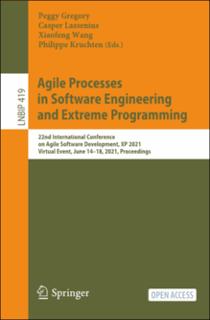| dc.contributor.author | Smite, Darja | |
| dc.contributor.author | Mikalsen, Marius | |
| dc.contributor.author | Moe, Nils Brede | |
| dc.contributor.author | Stray, Viktoria | |
| dc.contributor.author | Klotis, Erik | |
| dc.date.accessioned | 2023-02-06T11:39:37Z | |
| dc.date.available | 2023-02-06T11:39:37Z | |
| dc.date.created | 2021-06-20T00:12:22Z | |
| dc.date.issued | 2021 | |
| dc.identifier.citation | Lecture Notes in Business Information Processing. 2021, 3-18. | en_US |
| dc.identifier.issn | 1865-1348 | |
| dc.identifier.uri | https://hdl.handle.net/11250/3048536 | |
| dc.description.abstract | Along with the increasing popularity of agile software development, software work has become much more social than ever. Contemporary software teams rely on a variety of collaborative practices, such as pair programming, the topic of our study. Many agilists advocated the importance of collocation, face- to-face interaction, and physical artefacts incorporated in the shared workspace, which the COVID-19 pandemic made unavailable; most software companies around the world were forced to send their engineers to work from home. As software projects and teams overnight turned into distributed collaborations, we question what happened to the pair programming practice in the work-from-home mode. This paper reports on a longitudinal study of remote pair programming in two companies. We conducted 38 interviews with 30 engineers from Norway, Sweden, and the USA, and used the results of a survey in one of the case com- panies. Our study is unique as we collected the data longitudinally in April/May 2020, Sep/Oct 2020, and Jan/Feb 2021. We found that pair programming has decreased and some interviewees report not pairing at all for almost a full year. The experiences of those who paired vary from actively co-editing the code by using special tools to more passively co-reading and discussing the code and solu- tions by sharing the screen. Finally, we found that the interest in and the use of PP over time, since the first months of the forced work from home to early 2021, has admittedly increased, also as a social practice. | en_US |
| dc.language.iso | eng | en_US |
| dc.publisher | Springer | en_US |
| dc.relation.uri | https://library.oapen.org/bitstream/handle/20.500.12657/49499/9783030780982.pdf?sequence=1#page=13 | |
| dc.rights | Navngivelse 4.0 Internasjonal | * |
| dc.rights.uri | http://creativecommons.org/licenses/by/4.0/deed.no | * |
| dc.subject | Agile | en_US |
| dc.subject | Pair programming | en_US |
| dc.subject | Distributed | en_US |
| dc.subject | Remote | en_US |
| dc.subject | WFH | en_US |
| dc.subject | COVID-19 | en_US |
| dc.title | From Collaboration to Solitude and Back: Remote Pair Programming During COVID-19 | en_US |
| dc.type | Peer reviewed | en_US |
| dc.type | Journal article | en_US |
| dc.description.version | publishedVersion | en_US |
| dc.rights.holder | © The Author(s) 2021 | en_US |
| dc.source.pagenumber | 3-18 | en_US |
| dc.source.volume | XP 2021 | en_US |
| dc.source.journal | Lecture Notes in Business Information Processing | en_US |
| dc.identifier.doi | 10.1007/978-3-030-78098-2_1 | |
| dc.identifier.cristin | 1916996 | |
| dc.relation.project | Norges forskningsråd: 309344 | en_US |
| cristin.ispublished | true | |
| cristin.fulltext | original | |
| cristin.qualitycode | 1 | |

